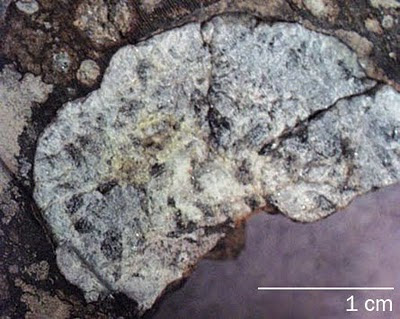 El sistema solar podría ser casi dos millones de años más viejo de acuerdo a un nuevo estudio.
El sistema solar podría ser casi dos millones de años más viejo de acuerdo a un nuevo estudio.Los datos procedentes de un meteorito recogido en el desierto del Sahara muestran que el sistema Solar se formó hace 4.568,2 millones de años, es decir de 0,3 a 1,9 millones de años antes de lo que dicen otras estimaciones.
“Todas las cosas interesantes que queremos comprender sobre la química de nuestro sistema solar ocurrieron entre los primeros 5 y 10 millones de años” dice Meenakshi Wadhwa, coautor del estudio y cosmoquímica en la Universidad del Estado de Arizona en Tempe. “Dos millones más atrás, es una proporción substancial de esos 5 a 10 millones de años”
El meteorito contiene trozos de tamaños entre 1 mm y 1 cm de substancias ricas en calcio y aluminio, algunos de los materiales más viejos encontrados nunca en las rocas primordiales. Se cree que estas inclusiones están entre los primeros sólidos que se condensaron a partir del gas al comienzo de la formación del sistema Solar. Junto a otros materiales de la nube pre-solar, las inclusiones crecieron como bolas de nieve transformándose en objetos más grandes que, con el tiempo, formaron asteroides y planetas.
Los autores midieron las relaciones de las variantes de átomos de plomo originados por el decaimiento radioactivo del uranio, cuando se formaron las inclusiones. Como el uranio decae a una velocidad conocida, las cantidades de plomo encontradas permiten a los científicos calcular cuanto tiempo hace que se formó el polvo espacial
Dos meteoritos analizados anteriormente por la misma técnica sugerían que los primeros sólidos del sistema solar se formaron entre 4.567,1 y 4.567,6 millones de años atrás. Pero estas cifras no son consistentes con otros “relojes” radioactivos presentes en las mismas rocas, como el basado en el decaimiento del aluminio en magnesio.
En el nuevo meteorito, las edades encontradas por ambos relojes, coinciden. Probablemente, la nueva roca sufrió menos calentamiento y bombardeo cuando formaba parte de un asteroide, que los otros meteoritos, y así sufrió menores cambios químicos.
El meteorito, del tamaño de un balón de softball, fue encontrado en Marruecos en 2004 y pesa un poco más de 1,2 kg.
 The solar system may be almost 2 million years older than previously thought, a new study shows.
The solar system may be almost 2 million years older than previously thought, a new study shows.Data from a newly studied meteorite recovered from the Saharan Desert show that the solar system formed 4,568.2 million years ago, 0.3 million to 1.9 million years earlier than other estimates. The results were published online August 22 in Nature Geoscience.
“All the interesting things we want to understand about the chemistry of our solar system happened within the first five to 10 million years,” says study coauthor Meenakshi Wadhwa, a cosmochemist from Arizona State University in Tempe. “When you push it back by 2 million years, that’s a substantial proportion of that 5 to 10 million years.”
The meteorite contains millimeter- and centimeter-sized bits of calcium- and aluminum-rich substances, some of the oldest material ever found in primordial rocks. These pockets in the rock, called inclusions, are believed to be among the first solids that condensed from gas at the beginning of the solar system’s formation. Along with other materials in the presolar cloud, the inclusions snowballed into larger objects, eventually forming asteroids and planets.
Study coauthor Audrey Bouvier of Arizona State measured the ratios of variants of lead atoms produced by the radioactive decay of uranium present when the inclusions formed. Since uranium decays at a known rate, current amounts of lead forms, or isotopes, allow scientists to calculate how long ago the space dust formed.
Two meteorites previously analyzed for their lead-isotope ratio suggested the first solar system solids formed 4,567.1 million to 4,567.6 million years ago. But these ages were inconsistent with other radioactive “clocks” in the same rocks, such as one based on the decay of an aluminum isotope to magnesium.
The uranium-lead decay age is consistent with other clocks in the new meteorite. The rock probably went through less heating and bombardment when it was part of an asteroid than the previously studied meteorites did, the authors say, so it experienced less chemical change.
The softball-sized meteorite was found in Morocco in 2004 and weighs a little over three pounds.
Tomado de/Taken from Science News
No hay comentarios:
Publicar un comentario